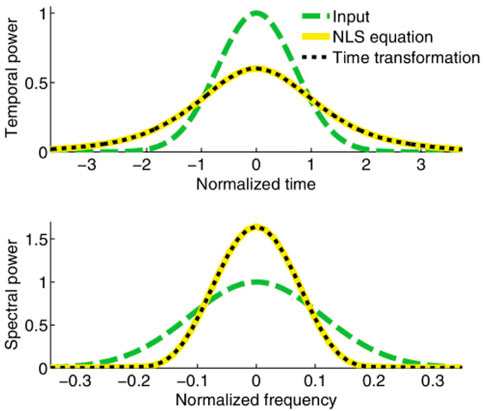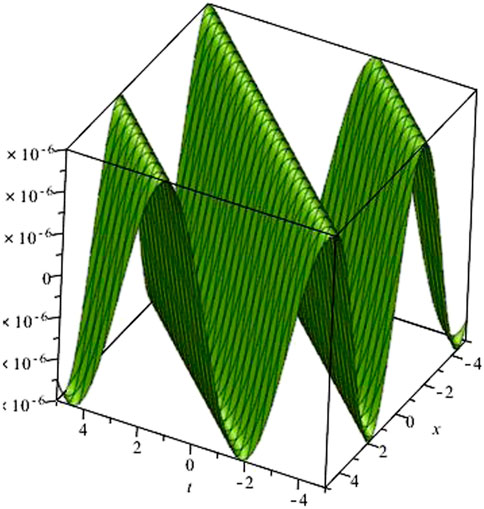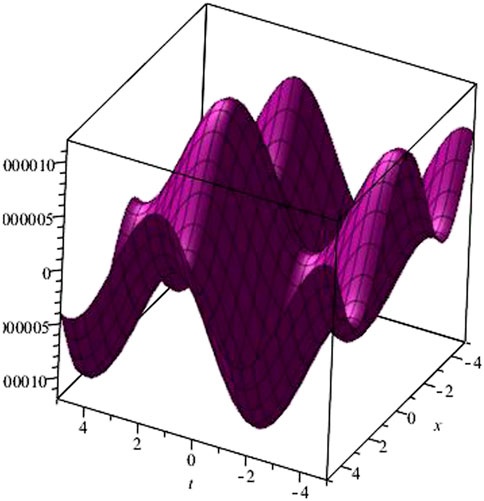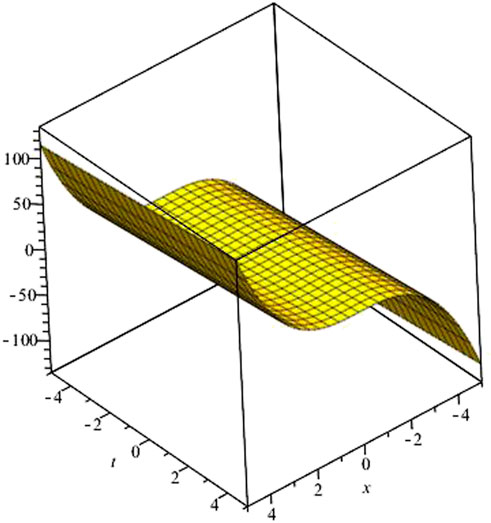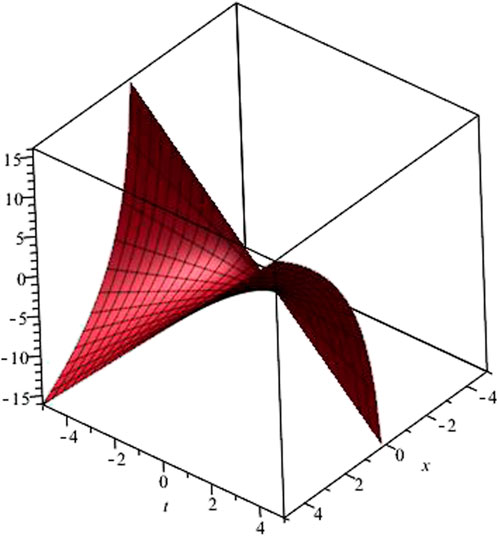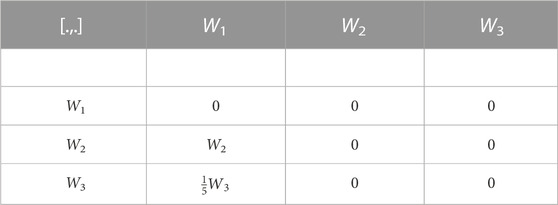- 1Department of Mathematics, University of Punjab, Lahore, Pakistan
- 2Department of Mathematics, Division of Science and Technology, University of Education, Lahore, Pakistan
Around 1880, Lie introduced an idea of invariance of the partial differential equation (PDE) under one-parameter Lie group of transformation to find the invariant, similarity, or auto-model solutions. Lie symmetry analysis (LSA) provides us an algorithm to search for point symmetries for solving related linear systems for infinitesimal generators. Actually, point symmetries lead us to one-parameter family of solutions from a known solution. LSA is a program that provides us the exact solutions for the non-linear differential equations (DEs) in analogy of the program designed by Galois for algebraic polynomial equations. In this paper, we have carried out the LSA for computing the similarity solutions (symmetries) of the non-linear short pulse equation (SPE) for the cases when h(u) = eu, k(u) = uxx,
1 Introduction
Galois used the group theory to discuss the solvability of algebraic polynomial equations. Sophus Lie used the same idea foe differential equations and devised a comprehensive program now known as Lie symmetry analysis (LSA). In his attempt, he also developed the theory of Lie groups with broad applications in many areas of mathematics, physics, and in applied sciences [1, 2]. [3] have explained the procedure of symmetry reductions and exact solutions for the non-linear PDEs using three different methods that are direct, classical, and non-classical. [4] used LSA for systems of non-linear PDEs including the solutions, for system of non-linear coupled PDEs in real physical application, for the unsteady liquid and gas flow in long pipelines, for approximated long wave equations in shallow water and for the general dispersive long-wave equation.
Non-linear short pulse equation (SPE) represents the propagation of ultra-short pulses (light pulses) in optical fibers of silica [5]. Propagation of pulses in optical fibers was first depicted by the cubic non-linear Schrodinger equation (NLSE) which are used to provide the actual fiber connections and refer new systems of fiber communication to attain very high data transmission [6, 7]. Research studies on a large scale have been performed for the propagation of ultra-short pulses (very narrow pulses) that permit high quality fast data transmission [6, 8]. In case of short pulses (or ultra-short pulses), the rationality of NLSE lacks due to the breakdown, [9]. Also, the higher order terms that are involved in cubic NLSE cause difficulties, see Figure 1, for the behavior of NLSE as an output [10]. Therefore, determined the SPE which provides more accurate approximation of the solution of Maxwell’s equation in non-linear media rather than the NLSE [6]. The SPE has vast applications in many applied fields such as systems of impulse, mechanics, neural networks, and in many other fields of sciences. Determined the symmetries of SPE and travelling wave solution by parametric representation and power series process, respectively, [11]. Evaluated the symmetry reductions and conservation laws by using the direct method for SPE, [12]. Authors also determined the Lie symmetries for SPE through the non-local system. Established the results for well-posedness of solutions which are bounded for homogenous IBVP and Cauchy problem connected with SPE, [5]. Matsuno constructed multiple exact solutions by using the direct method for three novel PDEs related with generalizations of SPE that are integrable, [13]. He gave the parametric representation of multi-soliton solutions of generalized SPE. LSA has been used by many mathematicians to explore the results related to the exact solutions of non-linear PDEs which depict physical phenomena [14]. Discussed the class of non-linear PDEs having an arbitrary order [15]. Authors estimated the determining equations for non-classical symmetries by using compatibility of original equations with invariant surface conditions.
In this article, we have discussed the LSA for one of the modified form of SPE and see graphical behavior of the functions depending upon 1-parameter (ϵ) Lie groups. The non-linear SPE is as follows:
where u(x, t) is the magnitude of electric field. α and β are the real parameters. Considering the SPE of the following form
where we let the general functions h(u) and k(u) as:
• h(u) = eu and k(u) = uxx,
•
It is worth mentioning that the case h(u) = un and k(u) = uxx for Eq. 2 has been recently discussed in the article [16]. We will find Lie point symmetries corresponding to the aforementioned cases and the optimal system with reductions and see their graphical behavior corresponding to the Lie symmetries.
2 Results
In the present section, we give our main results with computations.
2.1 Lie symmetries of SPE for the case of h(u) = eu and k(u) = uxx
Eq. 2 becomes
Consider the one parameter Lie group of point transformations for Eq. 3.
where ϵ ∈ R is the group parameter.The group generator of (4) is defined in the following vector form as:
where λ, μ and ν are infinitesimal functions of group variables. The second prolongation of the infinitesimal generator along with coefficients has the following form:
where Dx and Dt are the total derivatives.
Apply the second prolongation of the infinitesimal generator Eq. 5 onto Eq. 3. Then, in order to calculate symmetry of Eq. 3, we have the equation of the following form:
Solving this equation
Substitute the values of νxx, νxt and Eq. 3 which leads to an under-determined system of equations given as:
The solution of the aforementioned determining equations gives the coefficient functions in the form of
Theorem 3.1 The set of these generators is closed under the one parameter Lie groups
where ϵ ∈ R is the group parameter.Theorem 3.2 If
where
The Eq. 13 provides a class of solutions for Eq. 3 depending upon the parameter ϵ and general function
For first equation in Eq. 13, letting the general trigonometric function in place of
along-with ϵ = 0.000005 and abscissa x = −5 to 5, ordinate t = −5 to 5.
Figure 2 shows the graphical behavior of Eq. 15.letting another general value of function
Figure 3 shows the graphical view of Eq. 16.
For second equation of Eq. 13, considering a general function
Figure 4 shows its graphical view.
For last equation of Eq. 13, we let a general logarithmic function
Its graph is in Figure 5.
2.2 Optimal system of subalgebras
In this part, we will find the optimal system of one dimensional Lie subalgebras for Eq. 3 by using the adjoint representation. The corresponding commutator table and the adjoint table are as follows:Commutator Table: Adjoint Table:
Let us take a generator
Case No.1 For β1 ≠ 0, the generator turns to
Applying
furthermore, proceeding in the same way
which successively makes the coefficients β2 and β3 equal to 0and implies that W ≃ W1.Case No.2 Without loss of generality, here we take β1 = 0 and β2 = 1, the generator becomes
Now, act
Subcase No.2.1 If β3 < 0, then
Subcase No.2.2 If β3 > 0, then
Case No.3 For β1 = β2 = 0 and β3 = 1. Thus, in the meanwhile we have W ≃ W3.Case No.4 Let consider β1 = 0 = β3 and β2 ≠ 0. In this case, the generator is W ≃ W2.
The optimal system of one-dimensional subalgebras admitted by Eq. 3) is as follows:
2.3 Reductions and invariant solutions
2.3.1 Reduction by W2
The invariants for corresponding characteristic equation are as follows:
where a and b are arbitrary constants.
The invariant solution can be written in the form of b = f(a), implies that
substituting this value in Eq. 3), we obtain
The solution of this reduced equation for β = 1 is given in the form of solution set as.
2.3.2 Reduction by W3
The corresponding characteristic equation to this generator is as follows:
this gives two invariants
where a1 and b1 are arbitrary constants. It implies
putting this in Eq. 3, we obtain
which gives a trivial solution for u = f(x).
2.3.3 Reduction by W1
The characteristic equation is
solving this, we obtain corresponding invariants of the form
from this
where we obtain
substituting these derivatives into Eq. 3, we obtain
Thus, non-linear PDE (3) reduces to a non-linear ODE.
2.3.4 Reduction by W2 + W3
The invariants that we gain by solving characteristic equation are as follows:
a3 and b3 are arbitrary constants. The invariant solution corresponding to them is u = f (a3). Inserting this solution into Eq. 3 will give us a non-linear ODE of the form
2.3.5 Reduction by W2 − W3
The invariants corresponding to characteristic equation for this case are a4 = x + t and b4 = u. Furthermore, its invariant solution is given as u = f (a4). Therefore, the Eq. 3 will be converted into an ODE of the form
2.4 Determining lie symmetry of SPE for the case
The equation becomes
The one-parameter Lie group of transformations and the second prolongation with coefficients are given in Eqs 4, 6, respectively for Eq. 43. Let the generator be
Therefore, we have
simplification gives the following equation:
which is solved for the values of νxx and νxt, will give us the equation involving derivatives of infinitesimals with respect to dependent and independent variables and also the derivatives of dependent variable w.r.to independent variables. Substituting Eq. 43 and comparing the values of coefficients on both sides gives an under-determined system of equations
To solve this system, we consider ν as:
which satisfies the aforementioned equations and then by solving the aforementioned system, we obtain
c1 and c2 are any arbitrary constants. The infinitesimal generators for the one-parameter of Lie groups of transformations admitted in Eq. 43) are given by
These symmetry generators give us the symmetry groups
If u = R (x,t) is a solution of Eq. 43), then ui for i = 1, 2, and 3 and ϵ ≪ 1 also satisfies Eq. 43,
Commutator Table:also,
Adjoint Table.
Proposition 5.1: The generators Z1 = ∂t and Z2 = ∂x form a two-dimensional abelian Lie symmetry algebra.
2.5 Optimal system, reductions and invariant solutions
Considering a generator Z = b1Z1 + b2Z2. This generator will established a set of optimal system comprising of Lie algebra
where b1, and b2 are arbitrary constants. The reduction of PDE Eq. 39 by using the generator Z1 leads to an invariant solution u = f (c1). The reduced non-linear ODE will be
The reduction through Z2 generates a trivial case for Eq. 39.
3 Conclusion
In this paper, we have carried out the LSA for computing the similarity solutions (symmetries) of the non-linear SPE for the cases when h(u) = eu and k(u) = uxx and
Data availability statement
The original contributions presented in the study are included in the article/Supplementary Material; further inquiries can be directed to the corresponding author.
Author contributions
Article has been concieved by MM, drafted by HB and MA. All authors contributed to the article and approved the submitted version.
Conflict of interest
The authors declare that the research was conducted in the absence of any commercial or financial relationships that could be construed as a potential conflict of interest.
Publisher’s note
All claims expressed in this article are solely those of the authors and do not necessarily represent those of their affiliated organizations, or those of the publisher, the editors, and the reviewers. Any product that may be evaluated in this article, or claim that may be made by its manufacturer, is not guaranteed or endorsed by the publisher.
References
1. Oliveri F. Lie symmetries of differential equations: Classical results and recent contributions. Symmetry (2010) 2(2):658–706. doi:10.3390/sym2020658
2. Knight JC, Broeng J, Birks TA, Russell PSJ. Photonic band gap guidance in optical fibers. Science (1998) 282(5393):1476–8. doi:10.1126/science.282.5393.1476
3. Clarkson PA, Ludlow DK, Priestley TJ. The classical, direct, and nonclassical methods for symmetry reductions of nonlinear partial differential equations. Methods Appl Anal (1997) 4(2):173–95. doi:10.4310/maa.1997.v4.n2.a7
4. Liu H, Zhang L. Symmetry reductions and exact solutions to the systems of nonlinear partial differential equations. Physica Scripta (2018) 94(1):015202. doi:10.1088/1402-4896/aaeeff
5. Coclite GM, di Ruvo L. Well-posedness results for the short pulse equation. Z für Angew Mathematik Physik (2015) 66(4):1529–57. doi:10.1007/s00033-014-0478-6
6. Schäfer T, Wayne CE. Propagation of ultra-short optical pulses in cubic nonlinear media. Physica D: Nonlinear Phenomena (2004) 196(1-2):90–105. doi:10.1016/j.physd.2004.04.007
7. Agrawal GP. Nonlinear fiber optics. In: Nonlinear science at the dawn of the 21st century. Berlin, Heidelberg: Springer (2000). p. 195–211.
8. Karasawa N, Nakamura S, Nakagawa N, Shibata M, Morita R, Shigekawa H, et al. Comparison between theory and experiment of nonlinear propagation for a-few-cycle and ultrabroadband optical pulses in a fused-silica fiber. IEEE J Quan Electron (2001) 37(3):398–404. doi:10.1109/3.910449
9. Moloney JV, Newell AC. Nonlinear optics. Physica D: Nonlinear Phenomena (1990) 44(1-2):1–37. doi:10.1016/0167-2789(90)90045-q
10. Xiao Y, Maywar DN, Agrawal GP. New approach to pulse propagation in nonlinear dispersive optical media. JOSA B (2012) 29(10):2958–63. doi:10.1364/josab.29.002958
11. Liu H, Li J. Lie symmetry analysis and exact solutions for the short pulse equation. Nonlinear Anal Theor Methods Appl (2009) 71(5-6):2126–33. doi:10.1016/j.na.2009.01.075
12. Fakhar K, Wang G, Kara AH. Symmetry reductions and conservation laws of the short pulse equation. Optik (2016) 127(21):10201–7. doi:10.1016/j.ijleo.2016.08.013
13. Matsuno Y. Parametric solutions of the generalized short pulse equations. J Phys A: Math Theor (2020) 53(10):105202. doi:10.1088/1751-8121/ab6f18
14. Ali AT. New generalized Jacobi elliptic function rational expansion method. J Comput Appl Math (2011) 235(14):4117–27. doi:10.1016/j.cam.2011.03.002
15. El-Sabbagh MF, Ali AT. New generalized Jacobi elliptic function expansion method. Commun Nonlinear Sci Numer Simulation (2008) 13(9):1758–66. doi:10.1016/j.cnsns.2007.04.014
Keywords: short pulse equation, Lie point symmetry analysis, optimal system for lie subalgebras, reductions, invariant solutions
Citation: Mobeen Munir M, Bashir H and Athar M (2023) Lie symmetries and reductions via invariant solutions of general short pulse equation. Front. Phys. 11:1149019. doi: 10.3389/fphy.2023.1149019
Received: 20 January 2023; Accepted: 03 March 2023;
Published: 22 March 2023.
Edited by:
Gangwei Wang, Hebei University of Economics and Business, ChinaReviewed by:
Xinyue Li, Shandong University of Science and Technology, ChinaZenggui Wang, Liaocheng University, China
Copyright © 2023 Mobeen Munir, Bashir and Athar. This is an open-access article distributed under the terms of the Creative Commons Attribution License (CC BY). The use, distribution or reproduction in other forums is permitted, provided the original author(s) and the copyright owner(s) are credited and that the original publication in this journal is cited, in accordance with accepted academic practice. No use, distribution or reproduction is permitted which does not comply with these terms.
*Correspondence: Muhammad Mobeen Munir, bW11bmlyLm1hdGhAcHUuZWR1LnBr
 Muhammad Mobeen Munir
Muhammad Mobeen Munir Hajra Bashir2
Hajra Bashir2